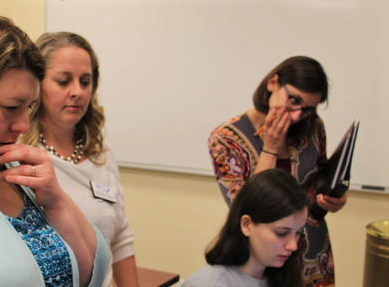
Kathryn Swacha
I study how specialized topics are communicated to audiences who need that information (click here to learn more about my field). Specifically, I am fascinated by how people navigate vast amounts of information regarding how to be ‘healthy’ — advice on what to eat, how much to exercise, which medications to take, which medical procedures to agree to, which doctors to trust, etc. How do we sort through all of this information to make decisions about our bodies that we feel comfortable with?
In a recent project, for example, I explored how older adults sort through health resources, most of which emphasize the medicalized aspects of aging while ignoring other factors important to health. For instance, an elderly woman who has recently been discharged from the hospital might take her medications faithfully because the hospital provided her with discharge papers that clearly explain which medications to take and when. Yet, she might also start skipping meals because she can’t afford to buy her medication AND enough healthy food. Findings like this one inspired me and my research participants—clients of a local senior center—to create some health resources tailored more specifically to these older adults’ everyday realities: for example, we created a cookbook with recipes that used exclusively food pantry ingredients and ran a PR campaign promoting the local Meals on Wheels program, which delivers hot meals directly to seniors’ doors.
Because I often survey, interview, or observe people in their daily lives in order to understand how they use health information, I’m always grappling with how to do such research in a way that can also benefit those people. My co-researcher, Jennifer Bay, and I recently analyzed what we call the ‘data imperative’—a push for more and more numerical information about people who use social services such as food pantries, clinics, or shelters. On the one hand, such information can lead to improved social services—for example, non-profit organizations often need to include ‘hard’ data in the grant applications that they write to ask for funds to expand their social programs. On the other hand, this push for data can give an incomplete picture of social problems by focusing mainly on measurable factors. For example, a national study on hunger recently moved to a digital format, in which participants responded to a survey on tablet computers, in an effort to protect participants’ privacy. However, as the volunteers responsible for asking people to complete that survey, we found that many of the participants preferred to chat with us rather than press their answers on the tablets, particularly when the survey’s multiple choice responses did not match their everyday experiences. In other words, they wanted another human being to hear their story rather than reduce it to a number. Or, many folks just needed someone to hold their baby, entertain their small children, or keep their place in the food pantry line, while they completed the survey, factors which the official survey protocol did not take into account! Based on these findings, we developed a model to help community-based researchers assess how their research might consider participants’ emotional and physical needs beyond collecting data.
